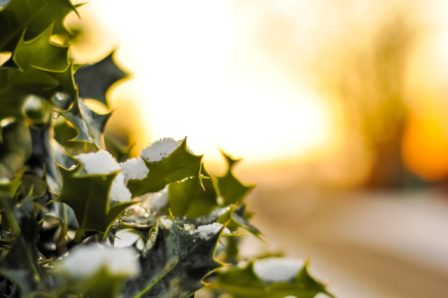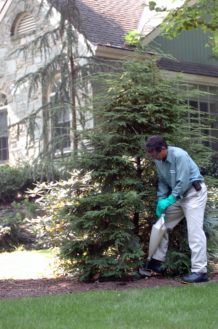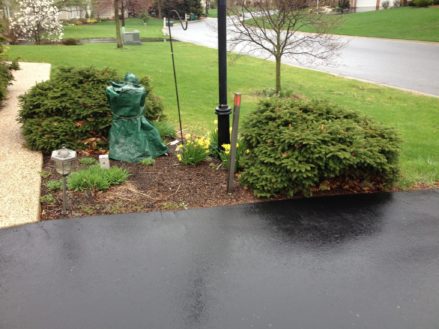
Winter Protective Sprays
This practice isn’t very common Central PA, but should be. Basically, the idea is to help prevent damage to evergreen plants in your landscape by providing them with some protection from the extreme temperatures that can cause damage in the Winter.
Let’s review some basics of plant biology. All plants go through a process where they take in water through their root systems and naturally release some through leaf or needle tissue. This process is called “transpiration.” If you’ve ever been on a hike on a summer day, you may have noticed it is more humid walking through a wooded area than an open field. This is due to transpiration – the trees are allowing a small amount of water to basically evaporate through the leaf tissue.
Winter damage to landscape plants occurs when plants transpire faster than they can take in more moisture. When the ground is frozen, plants can’t bring in moisture quickly enough to prevent damage from transpiration.
That’s where anti-desiccant sprays, also known as “Winter Protection” sprays, come into play. These sprays basically help to seal in the moisture present in the leaf/needle tissue. This coating slows the transpiration process with the goal of ensuring that the plant can intake and release the proper amount of water.
Plants to Treat
According to Michigan State University, there are specific plants you should target. Short-needled conifers (Eastern hemlock, Alberta spruce, Serbian spruce, juniper, etc.) should be sprayed. Also, broadleaf evergreens (boxwoods, rhododendrons, and hollies) are also at risk of winter damage and should be treated.
Preventing too much moisture from being released should help prevent Winter damage to the plant material. It’s not foolproof, but done regularly and well, makes a big difference. This is particularly important for plants susceptible to other pest or disease issues. For example, a series of well-timed Winter Protective sprays for boxwoods may reduce the risk of contracting boxwood blight. There’s no treatment currently available for boxwood blight, so reducing the likelihood of contraction can help prolong the life of the plant. This is a great way to ensure a healthy landscape for Winter.

Fertilization
The growing season brings a whole host of challenges to your landscape. There are always a number of stressors on your plants throughout the season.
These include pest pressure, disease pressure, heat stress, over watering, under watering, and depleted soil nutrients to name a few. That doesn’t even include any pressure the plant feels from pruning (proper or improper), damage from traffic compacting the soil, etc.
Again, a quick lesson in plant biology. Many plants store up a nutrient reserve, like a “rainy day” fund. When they’re under severe stress, they tap into that “fund” in order to help them get through a rough patch. You’ll often see this with trees that are stressed; they will suddenly sprout new “branches” much lower on their trunks or branches. The only place you should see leaves emerging on a tree is at the end of a branch. When these little “water sprouts” emerge off the trunk or lower on branches, you know the tree is under stress and is utilizing this nutrient reserve to try and compensate.
Fertilization makes sure that these “rainy day funds” on your landscape plants are topped off. It helps the plants to fight off stress from the Winter and emerge healthy and full the following Spring if you’ve fertilized late Fall. All plants in your landscape can benefit from this service, but especially those that aren’t “looking good.” If your plant doesn’t look “normal,” you should probably have it fertilized to help it recover from stress. Don’t overlook this important step!

Make Sure Plants Are Sited Properly
This one is a little tricky, especially for landscapes that are already well established. The principle is pretty simple: don’t place plants in places that are bad for them during the Winter.
It sounds easy but is harder than it looks, as there’s a lot to consider. Even an untrained professional can look at certain things and predict where problems will arise. For example, where do you “dump” your snow when you shovel it? Most of us put it right along the edges of the walkway or driveway, right?
Well, is that pattern of snow piling up over and over again going to put additional stress on the plant you want to go there? If so, you may want to consider placing that particular plant in another location.
Other considerations have to do with the plants themselves. Does the plant you want need full sun or partial shade? What’s the drainage of like? Some plants require great drainage, while others prefer a moist soil. What about soil pH? Again, some like a balanced soil and other plants require an acidic or alkaline soil.
An important consideration for Winter is the salt tolerance of plants. Some plants do not do well with high salt content in the soil, like white pines and boxwoods. Plants sited along a walkway or roadway (where plow trucks will be close) that do not respond well to high levels of salt could be problematic.
If you’re unsure of plant selection and placement, consultation with a professional might be in your best interest to ensure the overall health of the landscape. If you live locally and would like to speak with us about preparing your landscape for Winter, you can contact us today.

